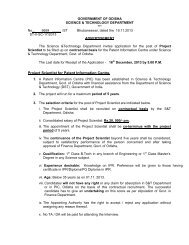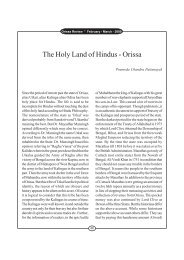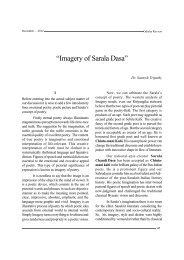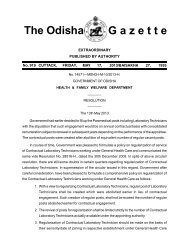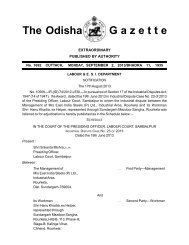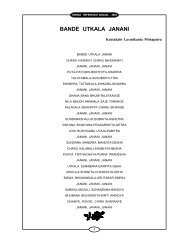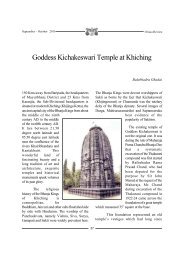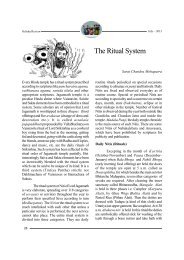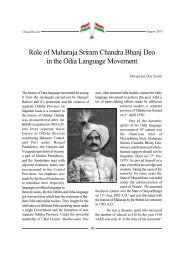Create successful ePaper yourself
Turn your PDF publications into a flip-book with our unique Google optimized e-Paper software.
Orissa Review * July - 2005<br />
starts on Snana Vedi. In Ganesh Vesha, the Lords<br />
appear very attractive and Anabasar day begins<br />
for fifteen days. In the month <strong>of</strong> Ashadha - Ratha<br />
and Bahuda <strong>Yatras</strong> are celebrated. This Yatra<br />
(festival) is the greatest and most important among<br />
all festivals. It attracts piligrims from all over the<br />
world. In Skanda Purana, the festival has been<br />
described as Mohavedi Mohoschhaba Yatra. It<br />
was the pious wish and order <strong>of</strong> Supreme God<br />
to king Indradyumna to arrange this festival in<br />
every year and to drive Him to holy land <strong>of</strong> <strong>Sri</strong><br />
Nrusingha. In three chariots namely Taladhwaja<br />
for God Balabhadra, Devidalana for Goddess<br />
Subhadra and Nandighosa for God <strong>Sri</strong> <strong>Jagannath</strong>,<br />
all deities are carried. In Devidalana, the Sudarsan<br />
wheel designed as a log <strong>of</strong> wood is seated on<br />
Her left side. The movable deities <strong>Sri</strong> Balaram<br />
and <strong>Sri</strong>krishna in Taladhwaja and <strong>Sri</strong><br />
Madanmohan dev in Nandighosa are also carried.<br />
All sects join in this festival. God <strong>Jagannath</strong> is<br />
Supreme Bramhan and Purusottama. The greatest<br />
psychic impact i.e. sense <strong>of</strong> unity, integrity and<br />
brotherhood bind all piligrims into one entity. The<br />
social life and spiritual life become one and same.<br />
After Bahuda Yatra, when deities are carried into<br />
the Temple in Pahandi, the last door closing<br />
ceremony is observed in inner sanction <strong>of</strong> the main<br />
Temple. The door opens by the order <strong>of</strong> Laxmi<br />
after getting satisfactory nine answers from <strong>Sri</strong><br />
<strong>Jagannath</strong>. In last answer, the social status and<br />
freedom <strong>of</strong> ladies are recognised by <strong>Sri</strong><br />
<strong>Jagannath</strong>.<br />
In the month <strong>of</strong> Shravan - the Golden<br />
Pendants, studded with diamond, sapphire,<br />
emerald, blood stone, and blue gem etc. are<br />
placed on foreheads <strong>of</strong> the deities. This is called<br />
Chitalagi and the birthday ceremony <strong>of</strong><br />
Balabhadra is also observed.<br />
In Bhadrava - birthday <strong>of</strong> <strong>Sri</strong>krishna is<br />
observed. The Yatra begins from birth till killing<br />
<strong>of</strong> Kansa Asura. During the entire period,<br />
Nandoatchhab, Kolibika, Kaliyadalan (Defeat <strong>of</strong><br />
55<br />
Blacksnake by <strong>Sri</strong>krishna), Killing <strong>of</strong> eight demons<br />
(generals <strong>of</strong> king Kansa), stealing game and<br />
Kansa's death etc. are observed for nineteen days.<br />
In these rites and rituals, the local inhabitants <strong>of</strong><br />
ancient streets (Sahis) take part directly. They<br />
use to hold meetings and decide democratically<br />
as to who will act as a demon. One person from<br />
each Sahi on each appointed day is dressed and<br />
decorated as a demon to display his game and<br />
lila as per custom and tradition. The movable<br />
representative deity <strong>of</strong> <strong>Sri</strong> <strong>Jagannath</strong> i.e. <strong>Sri</strong><br />
Madan Mohan after being permitted by Lord<br />
<strong>Jagannath</strong> takes part in this festival.<br />
In the month <strong>of</strong> Aswina - Durga puja<br />
festival is celebrated for sixteen days. <strong>Sri</strong> Madhab<br />
otherwise known Balapurusottam and Goddess<br />
Durga together get united for the entire period<br />
and Durgamadhab Rath Yatra is observed for nine<br />
days and golden Rajavesha is observed on<br />
Dasahara day.<br />
In the month <strong>of</strong> Kartika a special Bhog<br />
called Balabhog is <strong>of</strong>fered and different Veshas<br />
and decorations are made. Among those<br />
Radhadamodara vesha continues from Dasahara<br />
Ekadasi day to next tenth day. After newmoon<br />
till full moon on every monday Harihara vesha is<br />
observed for deity <strong>Sri</strong> Balabhadra. Harihara vesha<br />
make the Lord half black and half white. <strong>Sri</strong><br />
<strong>Jagannath</strong> is decorated and dressed in<br />
Laxminarayana vesha which begins from<br />
Dasahara Ekadasi day. On twelfth day Baman or<br />
Bankachuda vesha, on thirteenth day Tribikram<br />
or Dalikia vesha and on fourteenth day Laxmi<br />
Nrushingha vesha are performed and celebrated.<br />
In the month <strong>of</strong> Margasira - Dipa Dana<br />
ceremony and Pitrushradha are observed. A tree<br />
is artistically erected on the ground in inner sactum<br />
below Ratnasinghasan with sundried rice. After<br />
it is purified, ghee earthen lamps (dipa) are placed<br />
on different portions <strong>of</strong> said tree and then other<br />
customary rituals follow. The outer part <strong>of</strong> temple



